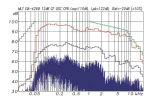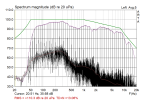solderdude
Grand Contributor
I know my proposal is not a standard and maybe even nonsensical but here it goes.
Did some dgging into spectra of music in AES papers and other research (also from MQA Bob) and found quite a lot of data on the spectra of music. Even across various genres which do have some differences but aside from bass levels do not differ that much.
Anyway.. as is well known music spectrum is closer to pink noise than white noise. Yet... the multitone signal is basically 'white noise shaped' in peak levels.
So was wondering how multitones would look like if the stimulus would be more 'pink noise' in spectrum or maybe even more like the spectrum below.
As music is not about average levels but more about impulses and peak levels (which multitone looks like as a signal) I found the 'average level' research to be close to the green line I drew in below.
But in the research for peak levels (which is what music is more about) I found a similar slope but about 20dB higher in level and a decade higher in frequency.

Of course in reality the low bass levels differ (per genre mostly) and above 10kHz the drop is steeper.
The question (mostly to @amirm) is would it make sense to shape the multitone in spectrum in a similar way (to get closer to audio content) ?
Did some dgging into spectra of music in AES papers and other research (also from MQA Bob) and found quite a lot of data on the spectra of music. Even across various genres which do have some differences but aside from bass levels do not differ that much.
Anyway.. as is well known music spectrum is closer to pink noise than white noise. Yet... the multitone signal is basically 'white noise shaped' in peak levels.
So was wondering how multitones would look like if the stimulus would be more 'pink noise' in spectrum or maybe even more like the spectrum below.
As music is not about average levels but more about impulses and peak levels (which multitone looks like as a signal) I found the 'average level' research to be close to the green line I drew in below.
But in the research for peak levels (which is what music is more about) I found a similar slope but about 20dB higher in level and a decade higher in frequency.
Of course in reality the low bass levels differ (per genre mostly) and above 10kHz the drop is steeper.
The question (mostly to @amirm) is would it make sense to shape the multitone in spectrum in a similar way (to get closer to audio content) ?
Last edited:



